Characterization of Gas–Liquid Two-Phase Slug Flow Using Distributed Acoustic Sensing in Horizontal Pipes
Abstract
1. Introduction
2. Materials and Methods
3. Data Processing Workflow and Results
3.1. DAS Data Processing Workflow
- (a)
- The waterfall, a plot of distance versus time, is generated for each slug.
- (b)
- A linear moveout correction (LMO) is applied, which is a velocity correction to shift traces in time based on an assumed velocity. The best velocity reflects the most consistency of the waveform among traces in time after the correction. The following equation represents the linear moveout correction:where n represents the trace number in the channel direction, d(n) is the fiber distance of the channel , v represents the testing velocity, and represents the time shift applied to the channel.
- (c)
- The semblance is a quantitative measure of the waveform similarity from different channels, which is a metric commonly used in seismic processing. It is calculated using the following equations:where is the summation of all waveforms in the channel direction, which is then squared and summed again in the time direction. fn(t) represents the data value of channel at time . is the total number of channels, is the half window length in time for the semblance calculation, and is the center of the time window.where E(t0) is the summation of the square of all waveforms in both channel and time directions.Finally, is the normalized semblance value of all the channels for the testing velocity . An array of the different testing velocities versus semblance can be obtained, and the best velocity is chosen at the maximum semblance value which represents the highest consistency of waveforms after linear moveout correction. This can be used as the estimation of the slug translational velocity after applying a fiber-length-to-pipe-length ratio of 169:1.
- (d)
- All the signals are stacked vertically in the channel direction after the linear moveout correction using the best velocity, and the negative peak is identified with its start and end times, which represent the slug’s front and tail.
3.2. High-Speed Camera Data Processing
- (a)
- The time when the slug front starts is determined once reaching the scale, tSF.
- (b)
- The time when the slug tail reaches the scale is documented, tST.
- (c)
- The time when the slug front reaches the beginning of the camera exposure is recorded, tSF_In.
- (d)
- The time when the slug front reaches the end of the camera exposure is recorded, tSF_Out.
- (e)
- Translational velocity, vT, is obtained by finding the length of the horizontal section that is exposed to the camera divided by the duration of exposure of each slug, i.e., vT = L/(tSF_Out − tSF_In).
- (f)
- Slug unit length is determined by LU = vT (tSF1 − tSF2), where (tSF1 − tSF2) is the time interval between two adjacent slugs.
- (g)
- The length of the slug body is determined by LS = vT (tSF − tST), and the length of the film region is determined using Equation 4 as presented previously.
- (h)
- Slug frequency, fS, is determined by counting the number of slugs divided by the corresponding recording time.
- (i)
- For each of the slug characteristic parameters obtained, the average and the median values were calculated over the full three-minute duration of the recorded video.
3.3. Data Validation
3.4. Slugs at Different Flowing Conditions
4. Discussion
5. Conclusions
Author Contributions
Funding
Institutional Review Board Statement
Informed Consent Statement
Data Availability Statement
Acknowledgments
Conflicts of Interest
References
- Stalford, H.; Ahmed, R. Intelligent Casing-Intelligent Formation (ICIF) Design. In Proceedings of the Offshore Technology Conference, Houston, TX, USA, 5–8 May 2014; p. D011S012R008. [Google Scholar]
- Zhong, Z.Y.; Zhi, X.L.; Yi, W.J. Oil Well Real-time Monitoring with Downhole Permanent FBG Sensor Network. In Proceedings of the 2007 IEEE International Conference on Control and Automation, Guangzhou, China, 30 May–1 June 2007; pp. 2591–2594. [Google Scholar]
- Falcone, G.; Hewitt, G.; Alimonti, C. Multiphase Flow Metering: Principles and Applications; Elsevier: Amsterdam, The Netherlands, 2009. [Google Scholar]
- Mukhopadhyay, S.C. New Developments in Sensing Technology for Structural Health Monitoring; Springer: Berlin/Heidelberg, Germany, 2011. [Google Scholar]
- Hill, D.; Fellow, S. Managing Oil and Gas with Fibre-Optic Sensing; EIC Energy Focus: London, UK, 2014. [Google Scholar]
- Kinet, D.; Mégret, P.; Goossen, K.W.; Qiu, L.; Heider, D.; Caucheteur, C. Fiber Bragg grating sensors toward structural health monitoring in composite materials: Challenges and solutions. Sensors 2014, 14, 7394–7419. [Google Scholar] [CrossRef]
- Hartog, A.H. An Introduction to Distributed Optical Fibre Sensors; CRC Press: Boca Raton, FL, USA, 2017. [Google Scholar]
- Boering, M.; Braal, R.; Cheng, L.K. Toward the next fiber optic revolution and decision making in the oil and gas industry. In Proceedings of the Offshore Technology Conference, Houston, TX, USA, 6–9 May 2013. [Google Scholar] [CrossRef]
- In’t Panhuis, P.; den Boer, H.; van der Horst, J.; Paleja, R.; Randell, D.; Joinson, D.; McIvor, P.; Green, K.; Bartlett, R. Flow monitoring and production profiling using DAS. In SPE Annual Technical Conference and Exhibition? SPE: Kuala Lumpur, Malaysia, 2014. [Google Scholar] [CrossRef]
- Raab, T.; Reinsch, T.; Aldaz Cifuentes, S.R.; Henninges, J. Real-time well-integrity monitoring using fiber-optic distributed acoustic sensing. SPE J. 2019, 24, 1997–2009. [Google Scholar] [CrossRef]
- Boone, K.; Ridge, A.; Crickmore, R.; Onen, D. Detecting leaks in abandoned gas wells with fibre-optic distributed acoustic sensing. In Proceedings of the IPTC 2014: International Petroleum Technology Conference, Doha, Qatar, 19–22 January 2014; European Association of Geoscientists & Engineers: Rotterdam, The Netherlands, 2014. [Google Scholar] [CrossRef]
- Jin, G.; Roy, B. Hydraulic-fracture geometry characterization using low-frequency DAS signal. Lead. Edge 2017, 36, 975–980. [Google Scholar] [CrossRef]
- Mateeva, A.; Lopez, J.; Mestayer, J.; Wills, P.; Cox, B.; Kiyashchenko, D.; Yang, Z.; Berlang, W.; Detomo, R.; Grandi, S. Distributed acoustic sensing for reservoir monitoring with, V.S.P. Lead. Edge 2013, 32, 1278–1283. [Google Scholar] [CrossRef]
- van der Horst, J.; den Boer, H.; in’t Panhuis, P.; Kusters, R.; Roy, D.; Ridge, A.; Godfrey, A. Fibre Optic Sensing for Improved Wellbore Surveillance. In Proceedings of the International Petroleum Technology Conference, Beijing, China, 26–28 March 2013. [Google Scholar] [CrossRef]
- Jin, G.; Friehauf, K.; Roy, B. The calibration of double-ended distributed temperature sensing for production logging purposes. In Proceedings of the SPE/AAPG/SEG Unconventional Resources Technology Conference, Denver, CO, USA, 22–24 July 2019. [Google Scholar] [CrossRef]
- Jin, G.; Friehauf, K.; Roy, B.; Constantine, J.J.; Swan, H.W.; Krueger, K.R.; Raterman, K.T. Fiber optic sensing-based production logging methods for low-rate oil producers. In Proceedings of the SPE/AAPG/SEG Unconventional Resources Technology Conference, Denver, CO, USA, 22–24 July 2019. [Google Scholar] [CrossRef]
- Titov, A.; Fan, Y.; Kutun, K.; Jin, G. Distributed Acoustic Sensing (DAS) Response of Rising Taylor Bubbles in Slug Flow. Sensors 2022, 22, 1266. [Google Scholar] [CrossRef]
- Titov, A.; Jin, G.; Fan, Y.; Tura, A.; Kutun, K.; Miskimins, J. Distributed fiber-optic sensing based production logging investigation: Flowloop experiments. First EAGE Workshop on Fibre Optic Sensing. Eur. Assoc. Geosci. Eng. 2020, 2020, 1–5. [Google Scholar] [CrossRef]
- Titov, A.; Fan, Y.; Jin, G.; Tura, A.; Kutun, K.; Miskimins, J. Experimental investigation of distributed acoustic fiber-Optic Sensing in production logging: Thermal slug tracking and multiphase flow characterization. In SPE Annual Technical Conference and Exhibition? Day 4 Thu, October 29, 2020; SPE: Kuala Lumpur, Malaysia, 2020. [Google Scholar] [CrossRef]
- Weber, G.H.; dos Santos, E.N.; Gomes, D.F.; Santana, A.L.B.; da Silva, J.C.C.; Martelli, C.; Pipa, D.R.; Morales, R.E.; de Camargo Júnior, S.T.; da Silva Junior, M.F.; et al. Measurement of Gas-Phase Velocities in Two-Phase Flow Using Distributed Acoustic Sensing. IEEE Sens. J. 2023, 23, 3597–3608. [Google Scholar] [CrossRef]
- Al-Safran, E.M.; Brill, J.P. Applied Multiphase Flow in Pipes and Flow Assurance: Oil and Gas Production; Society of Petroleum Engineers: Kuala Lumpur, Malaysia, 2017. [Google Scholar]
- Al-Kayiem, H.H.; Mohmmed, A.O.; Al-Hashimy, Z.I.; Time, R.W. Statistical assessment of experimental observation on the slug body length and slug translational velocity in a horizontal pipe. Int. J. Heat Mass Transf. 2017, 105, 252–260. [Google Scholar] [CrossRef]
- Raimondi, L. Gas/liquid two-phase flow in pipes: Slugs, classical flow-map, and 1D compositional simulation. SPE J. 2022, 27, 532–551. [Google Scholar] [CrossRef]
- Ekinci, S. Pipe Inclination Effects on Slug Flow Characteristics of High Viscosity Oil-Gas Two-Phase Flow. Master’s Thesis, The University of Tulsa, Tulsa, OK, USA, 2015. [Google Scholar]
- Brito, R. Effect of Medium Oil Viscosity on Two-Phase Oil-Gas Flow Behavior in Horizontal Pipes. Master’s Thesis, The University of Tulsa, Tulsa, OK, USA, 2012. [Google Scholar]
- Liu, Y.; Upchurch, E.R.; Ozbayoglu, E.M. Experimental Study of Single Taylor Bubble Rising in Stagnant and Downward Flowing Non-Newtonian Fluids in Inclined Pipes. Energies 2021, 14, 578. [Google Scholar] [CrossRef]
- Gokcal, B. An Experimental and Theoretical Investigation of Slug Flow For High Oil Viscosity in Horizontal Pipes. Ph.D. Thesis, The University of Tulsa, Tulsa, OK, USA, 2008. [Google Scholar]
- Shoham, O. Mechanistic Modeling of Gas-Liquid Two-Phase Flow in Pipes; Society of Petroleum Engineers: Kuala Lumpur, Malaysia, 2006. [Google Scholar]
- Zhang, H.-Q.; Wang, Q.; Sarica, C.; Brill, J.P. Unified Model for Gas-Liquid Pipe Flow via Slug Dynamics—Part 1: Model Development. J. Energy Res. Technol. 2003, 125, 266–273. [Google Scholar] [CrossRef]
- Ludwig, E.E. Applied Process Design for Chemical and Petrochemical Plants: Volume 1; Elsevier Science: Amsterdam, The Netherlands, 1995. [Google Scholar]
- Fan, Y.; Soedarmo, A.; Pereyra, E.; Sarica, C. A comprehensive review of pseudo-slug flow. J. Pet. Sci. Eng. 2022, 217, 110879. [Google Scholar] [CrossRef]
- Fan, Y.; Pereyra, E.; Sarica, C. Experimental study of pseudo-slug flow in upward inclined pipes. J. Nat. Gas Sci. Eng. 2020, 75, 103147. [Google Scholar] [CrossRef]
- Bernicot, M.F.; Drouffe, J.-M. A Slug-Length Distribution Law for Multiphase Transportation Systems. SPE Prod. Eng. 1991, 6, 166–170. [Google Scholar] [CrossRef]
- Barnea, D.; Taitel, Y. A model for slug length distribution in gas-liquid slug flow. Int. J. Multiph. Flow 1993, 19, 829–838. [Google Scholar] [CrossRef]
- Al-Safran, E.M.; Sarica, C.; Zhang, H.Q.; Brill, J.P. Probabilistic/mechanistic modeling of slug-length distribution in a horizontal pipeline. SPE Prod. Facil. 2005, 20, 160–172. [Google Scholar] [CrossRef]
- Fan, Y.; Aljasser, M. Unified modeling of pseudo-slug and churn flows for liquid holdup and pressure gradient predictions in pipelines and wellbores. SPE Prod. Oper. 2022, 38, 350–366. [Google Scholar] [CrossRef]
- Abdulkadir, M.; Hernandez-Perez, V.; Lowndes, I.S.; Azzopardi, B.J.; Sam-Mbomah, E. Experimental study of the hydrodynamic behaviour of slug flow in a horizontal pipe. Chem. Eng. Sci. 2016, 156, 147–161. [Google Scholar] [CrossRef]
- Al-Safran, E.; Kora, C.; Sarica, C. Prediction of slug liquid holdup in high viscosity liquid and gas two-phase flow in horizontal pipes. J. Pet. Sci. Eng. 2015, 133, 566–575. [Google Scholar] [CrossRef]
- Suleimanov, R.I.; Ya Khabibullin, M. Optimization of the design of the scrubber separator slug catcher. IOP Conf. Ser. Mater. Sci. Eng. 2020, 905, 012090. [Google Scholar] [CrossRef]
- Nnabuife, S.G.; Tandoh, H.; Whidborne, J.F. Slug flow control using topside measurements: A review. Chem. Eng. J. Adv. 2022, 9, 100204. [Google Scholar] [CrossRef]
- Sun, J.; Jepson, W.P. Slug Flow Characteristics and Their Effect on Corrosion Rates in Horizontal Oil and Gas Pipelines; SPE: Kuala Lumpur, Malaysia, 1992. [Google Scholar] [CrossRef]
- Sarac, B.E.; Stephens, D.S.; Eisener, J.; Rosselló, J.M.; Mettin, R. Cavitation bubble dynamics and sonochemiluminescence activity inside sonicated submerged flow tubes. Chem. Eng. Process.—Process Intensif. 2020, 150, 107872. [Google Scholar] [CrossRef]
- Olbrich, M.; Bär, M.; Oberleithner, K.; Schmelter, S. Statistical characterization of horizontal slug flow using snapshot proper orthogonal decomposition. Int. J. Multiph. Flow 2021, 134, 103453. [Google Scholar] [CrossRef]



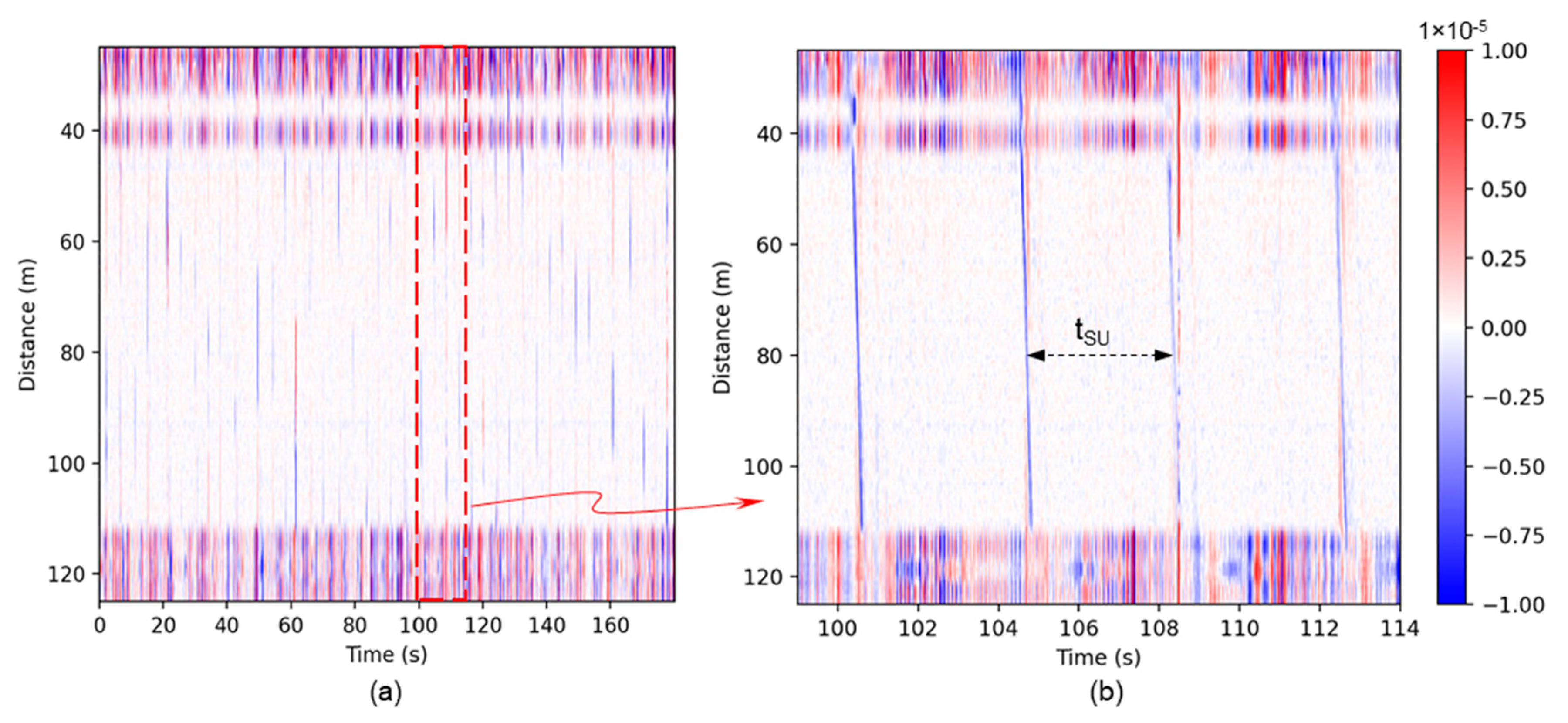


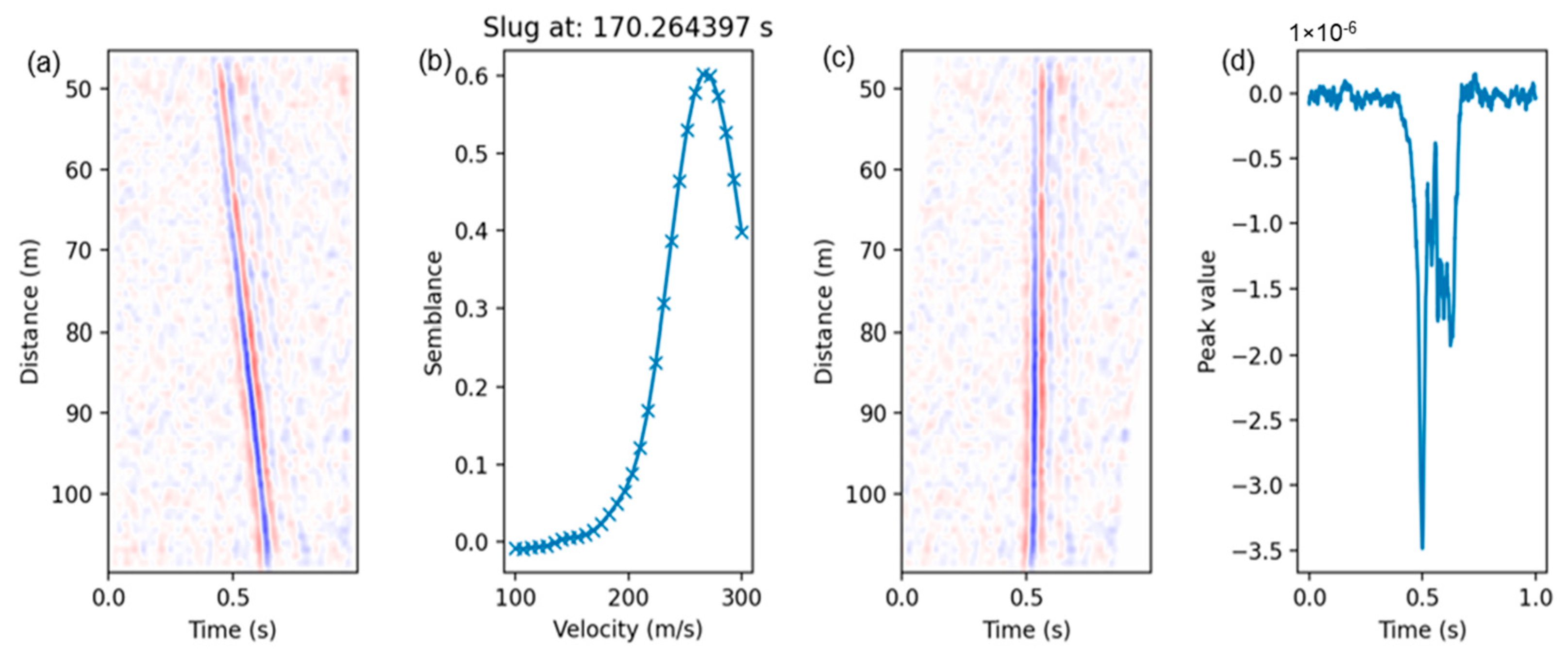



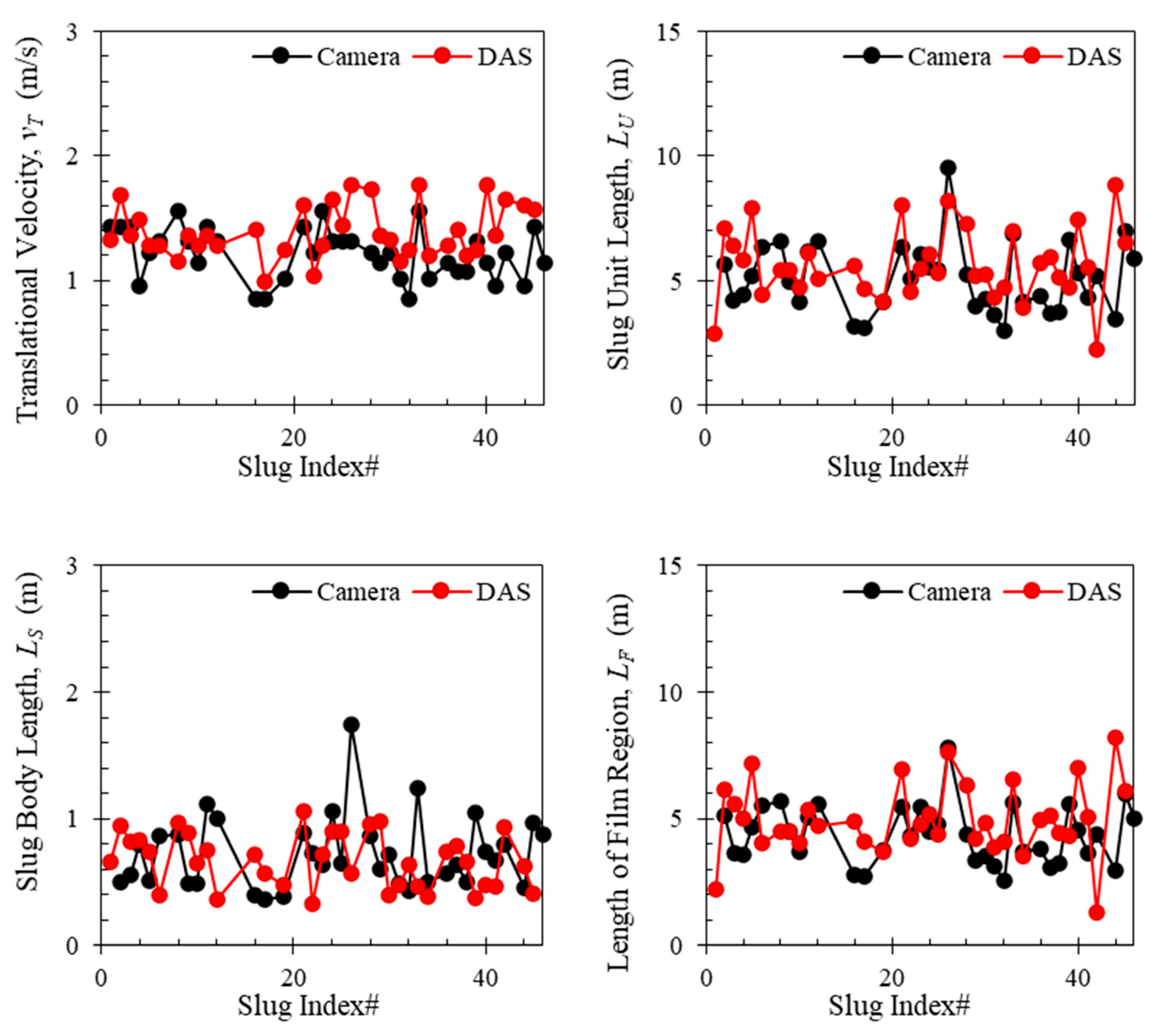
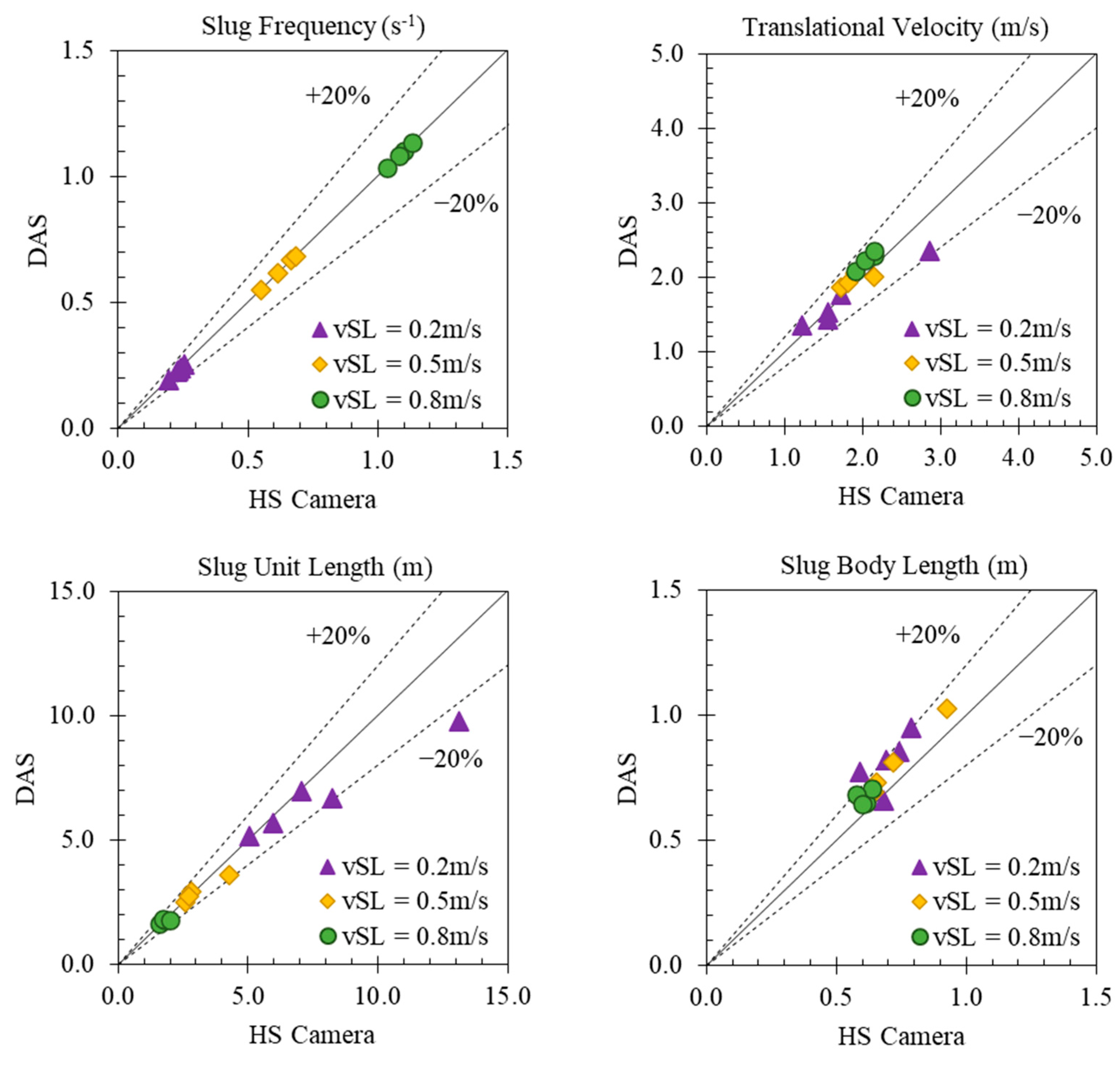


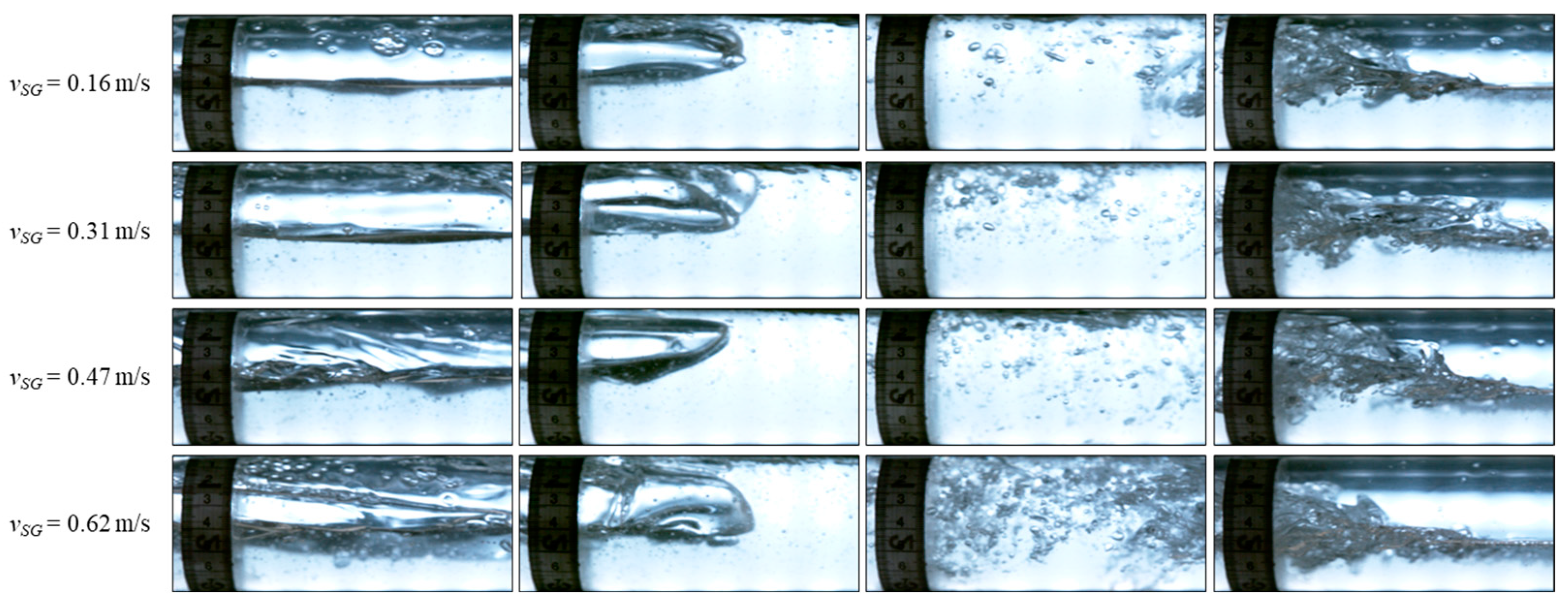

| Case# 1 | Superficial Oil Velocity [m/s] | Superficial Gas Velocity [m/s] |
|---|---|---|
| 1–5 | 0.2 | 0.16, 0.31, 0.47, 0.62, 0.78 |
| 6–9 | 0.5 | 0.16, 0.31, 0.47, 0.62 |
| 10–13 | 0.8 | 0.16, 0.31, 0.47, 0.62 |
| Parameters | Value | Parameters | Value |
|---|---|---|---|
| Slug#ID | 45 | tSlugFront (s) | 0.406 |
| Slug occurrence time (s) | 170.26 | tTail (s) | 0.668 |
| Semblance before correction | −0.008588 | tSS (s) | 0.262 |
| Best velocity (m/s) | 265.52 | Slug Frequency (s−1) | 0.239 |
| Semblance after correction | 0.602624 | Slug Body Length, LS (m) | 0.410 |
| Slug translational velocity, vT (m/s) | 1.565 | Liquid Film Region Length, LF (m) | 6.125 |
| tSU (s) | 4.176 | Negative Peak Time (s) | 0.500 |
| Slug Unit Length, LU (m) | 6.536 | Negative Peak Value | −3.487 × 10−6 |
| Parameters | Value | Parameters | Value |
|---|---|---|---|
| Slug#ID | 412 | tSlugFront (s) | 0.000 |
| Slug occurrence time (s) | 43.074 | tTail (s) | 0.673 |
| Semblance before correction | −0.004933 | tSS (s) | 0.673 |
| Best velocity (m/s) | 279.31 | Slug Frequency (s−1) | 1.429 |
| Semblance after correction | 0.024887 | Slug Body Length, LS (m) | 1.108 |
| Slug translational velocity, vT (m/s) | 1.6464 | Liquid Film Region Length, LF (m) | 0.046 |
| tSU (s) | 0.7 | Negative Peak Time (s) | 0.045 |
| Slug Unit Length, LU (m) | 1.154 | Negative Peak Value | 0.363 × 10−6 |
| Case # | vSO [m/s] | vSG [m/s] | P * [%] |
|---|---|---|---|
| 1 | 0.2 | 0.16 | 78 |
| 2 | 0.31 | 84 | |
| 3 | 0.47 | 88 | |
| 4 | 0.62 | 73 | |
| 5 | 0.35 | 63 | |
| 6 | 0.5 | 0.16 | 81 |
| 7 | 0.31 | 90 | |
| 8 | 0.47 | 88 | |
| 9 | 0.62 | 94 | |
| 10 | 0.8 | 0.16 | 94 |
| 11 | 0.31 | 94 | |
| 12 | 0.47 | 95 | |
| 13 | 0.62 | 98 |
Disclaimer/Publisher’s Note: The statements, opinions and data contained in all publications are solely those of the individual author(s) and contributor(s) and not of MDPI and/or the editor(s). MDPI and/or the editor(s) disclaim responsibility for any injury to people or property resulting from any ideas, methods, instructions or products referred to in the content. |
© 2024 by the authors. Licensee MDPI, Basel, Switzerland. This article is an open access article distributed under the terms and conditions of the Creative Commons Attribution (CC BY) license (https://creativecommons.org/licenses/by/4.0/).
Share and Cite
Ali, S.; Jin, G.; Fan, Y. Characterization of Gas–Liquid Two-Phase Slug Flow Using Distributed Acoustic Sensing in Horizontal Pipes. Sensors 2024, 24, 3402. https://doi.org/10.3390/s24113402
Ali S, Jin G, Fan Y. Characterization of Gas–Liquid Two-Phase Slug Flow Using Distributed Acoustic Sensing in Horizontal Pipes. Sensors. 2024; 24(11):3402. https://doi.org/10.3390/s24113402
Chicago/Turabian StyleAli, Sharifah, Ge Jin, and Yilin Fan. 2024. "Characterization of Gas–Liquid Two-Phase Slug Flow Using Distributed Acoustic Sensing in Horizontal Pipes" Sensors 24, no. 11: 3402. https://doi.org/10.3390/s24113402
APA StyleAli, S., Jin, G., & Fan, Y. (2024). Characterization of Gas–Liquid Two-Phase Slug Flow Using Distributed Acoustic Sensing in Horizontal Pipes. Sensors, 24(11), 3402. https://doi.org/10.3390/s24113402







